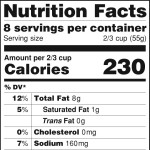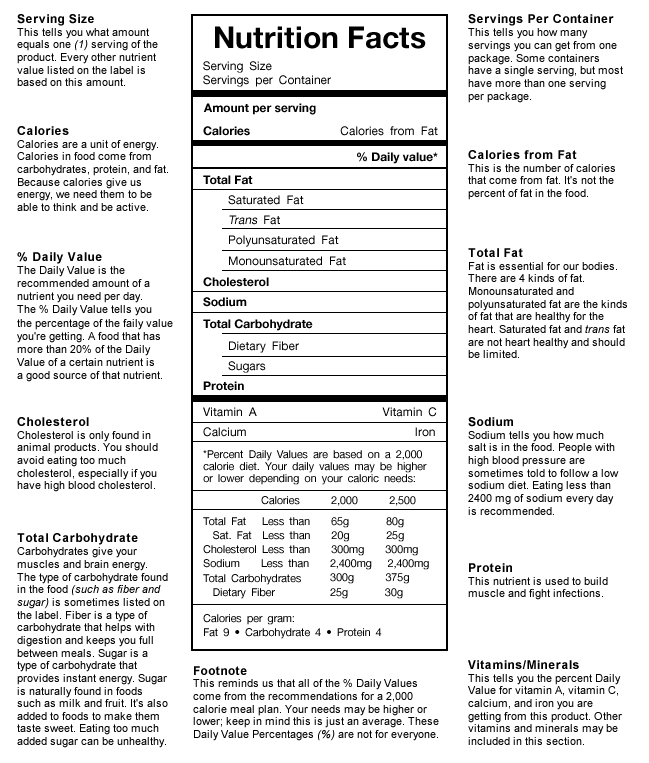- The nutrition facts label gives you information about the nutrients contained in that food.
- An important fact on the label is the serving size.
- The food label is based on a 2000-calorie diet, but many teens have different calorie needs.
- All food labels were updated in January 1, 2021

The Nutrition Facts Label explains what nutrients (components of food your body needs to grow and stay healthy) and how much of those nutrients are found in one serving of the food. The label is found on the outside of most food packages, but isn’t on most fresh foods (such as fruits and vegetables or meats). The Nutrition Facts label can help you make choices about the food you eat.
What will every Nutrition Facts Label have on it?
The label will have some or all of the following items listed:
- Serving Size: Serving size equals one serving of the product. All the other nutrient values listed on the label are based on this amount.
- Servings per Container: This number is how many servings you can get from one package. Some containers have a single serving, but most have more than one serving per package.
- Calories (total): Calories are a unit of energy that come from carbohydrates, protein and fat. Calories give us energy so our bodies can function.
- Calories from Fat: This number is the amount of calories that come from fat. It’s not the percent of fat in the food.
- % Daily Value: This value is the percentage of the recommended daily value for a nutrient that you get in one serving. A food that has more than 20% of the Daily Value of a micronutrient such as vitamins and minerals is an “excellent” source.
- Total Fat: Fat is essential for our bodies. It keeps us full after meals and helps us absorb certain vitamins.
- Trans Fat: Trans fat is unhealthy for your heart.
- Cholesterol: Cholesterol is a substance found only in animal products. Your body needs some cholesterol to make certain hormones and absorb Vitamin D. While cholesterol is found in some foods, our bodies also naturally make it and the levels can depend a lot on genetics.
- Sodium: Sodium is the amount of salt in the serving of food. Sodium is an important way our body stays hydrated and plays a vital role in regulating the amount of water in our tissues. People with high blood pressure are often told to follow a low sodium diet.
- Total Carbohydrate: Carbohydrates provide your muscles and brain with energy.
- Dietary Fiber: Helps with digestion and keeps you full between meals.
- Sugars: Sugar is a quick energy source but can often lead to fatigue later on. If a food contains added sugar (aka sugar that is not naturally found in the food), the amount will be listed underneath “sugars.”
- Examples of added sugars: white sugar, honey, and syrups
- Examples of naturally occurring sugars: lactose in dairy products, fructose in fruit
- Protein: This nutrient is used to build muscle and fight infections. It also helps you feel full after you eat.
- Vitamins and Minerals (Vitamin D, Calcium, Iron, Potassium):
- Vitamin D and Calcium: important for strong bones and are found in dairy products
- Iron: found in protein foods. If we have low iron, we might start to feel tired even just walking around.
- Other nutrients, such as polyunsaturated or monounsaturated fat and other vitamins and minerals, can also be put on the Nutrition Facts label if the company that makes the food wants them listed.
What should I look for on the Nutrition Facts Label?
The first thing you should look at is the serving size. The amount of each nutrient listed on the label tells you what’s found in one serving of that food, not in the whole container. It also is important to look at fiber, especially for grains like bread and crackers. For these foods, aim to buy products that have 3g or more of fiber, because fiber will keep you full between meals and snacks.
Do I need to read every Nutrition Facts Label?
No. You don’t need to read every nutrition facts label. Food labels are meant as a tool to help you choose foods that will give your body the nutrition it needs. For example, if you don’t drink much milk, you could read Nutrition Facts Labels to help you find foods that are high in calcium or vitamin D. You can also use the Nutrition Facts Label to compare two different foods. For example, if you are deciding between two different kinds of breads, looking at the labels for fiber can help you better understand the nutrient content of each bread.
The food label lists a 2000-calorie diet. Should I be eating 2000 calories?
Probably not. Many adolescents need more than 2000 calories as they grow in height, build bones, build muscles and stay active. The 2000-calorie diet is just an estimate and is used to help calculate the Percent (%) Daily Value listed on the food label.
An Example of a Food Label you might see.
Starting in 2021 all Nutrition Facts Labels were designed to look like this:

 Young Men's Health
Young Men's Health
